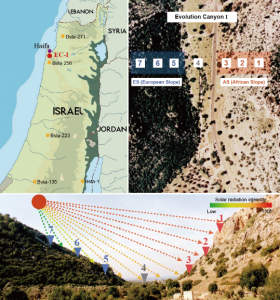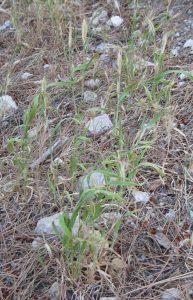Pilar Catalán publishes in PNAS a study on sympatric speciation of a selfing grass in “Evolution Canyon I”
The EPSHU researcher and member of the BIFI, University of Zaragoza, publishes this work on sympatric speciation of a selfing grass in “Evolution Canyon I” in collaboration with researchers from China and Israel.
 The prestigious journal PNAS publishes in its volume 120 of October 30, 2023 an article of high evolutionary interest, entitled Scattered differentiation of unlinked loci across the genome underlines ecological divergence of the selfing grass Brachypodium stacei. This work reflects the results of the research carried out by Pilar Catalán, researcher at the Higher Polytechnic School of Huesca and the BIFI of the University of Zaragoza, in collaboration with researchers from China and Israel.
The prestigious journal PNAS publishes in its volume 120 of October 30, 2023 an article of high evolutionary interest, entitled Scattered differentiation of unlinked loci across the genome underlines ecological divergence of the selfing grass Brachypodium stacei. This work reflects the results of the research carried out by Pilar Catalán, researcher at the Higher Polytechnic School of Huesca and the BIFI of the University of Zaragoza, in collaboration with researchers from China and Israel.
The study evidences the existence of sympatric speciation among populations of the model grass Brachypodium stacei that grow in a special geographical setting, “Evolution Canyon I” (Mount Carmel, Israel). It is a natural canyon that has two opposite slopes located at a very short distance from each other (200 m) but with very different microclimatic, ecological and biome conditions (arid and sabanoid “African” slope, and mesic and forested “European” slope) (photos 1 and 2), which has favored sympatric speciation processes of very diverse organisms, from bacteria to animals and plants.
 Image 1. Geographic location of Evolution Canyon I in Israel and physiognomy of its two opposing slopes showing their disparate microclimatic and ecological conditions (aridic “African” slope with sabanoid biome, and “European” slope, mesic and with forest biome) that have facilitated evolution in action across the tree of life (various groups of organisms).
Image 1. Geographic location of Evolution Canyon I in Israel and physiognomy of its two opposing slopes showing their disparate microclimatic and ecological conditions (aridic “African” slope with sabanoid biome, and “European” slope, mesic and with forest biome) that have facilitated evolution in action across the tree of life (various groups of organisms).

Image 2. Brachypodium stacei grass plants growing in the forest biome.
The theory of sympatric speciation postulates the emergence of different species in the absence of geographical barriers to gene flow, through divergent ecological adaptation of individuals from both populations. This model of sympatric speciation contrasts with the most commonly accepted model of allopatric speciation, according to which the existence of physical barriers to gene flow promotes rapid reproductive and genetic isolation between individuals from one population and the appearance of new species. However, sympatric speciation through ecological divergence has captivated evolutionists since Darwin, who considered it one of the triggering mechanisms for the origin of species.
It is the first time that the potential sympatric speciation of a highly selfing annual plant, in which gene flow between populations has taken place mainly by seed dispersal, has been studied. The authors of the work have demonstrated, through genomic, transcriptomic and metabolomic analysis of B. stacei individuals on both slopes of Evolution Canyon I that, despite the existence of gene flow and interbreeding between the two populations, an incipient speciation has occurred. It is based on the existence of different mutations in multiple unlinked loci in the individuals of each population; these individuals also show distinct phenotypes and contrasting adaptive responses (different expressions of drought tolerance genes) to conditions of extreme aridity in the sabanoid biome of the “African” population and mesic conditions in the forest biome of the “European” population.
The study has been developed by researchers from the University of Lanzhou (China), the Universities of Haifa and  Tel-Aviv (Israel) and the EPSHU-University of Zaragoza (Spain). One of the corresponding authors of the work, Prof. Eviatar Nevo (photo 3), is one of the main promoters of the theory of sympatric speciation; founder and member of the Institute of Evolution (University of Haifa), he is also an honorary member of the National Academy of Sciences (USA) and the Ukrainian Academy of Sciences. Two other corresponding authors, Profs. Jianquan Liu and Pilar Catalán are honorary members of the Botanical Society of America.
Tel-Aviv (Israel) and the EPSHU-University of Zaragoza (Spain). One of the corresponding authors of the work, Prof. Eviatar Nevo (photo 3), is one of the main promoters of the theory of sympatric speciation; founder and member of the Institute of Evolution (University of Haifa), he is also an honorary member of the National Academy of Sciences (USA) and the Ukrainian Academy of Sciences. Two other corresponding authors, Profs. Jianquan Liu and Pilar Catalán are honorary members of the Botanical Society of America.
The research has been funded by the Strategic Priority Research Program of Chinese Academy of Sciences (grant no. XDB31010300), Second Tibetan Plateau Scientific Expedition and Research program (grant no. 2019QZKK0502), and International Collaboration 111 Program (grant no. BP0719040) to Jianquian Liu and Eviatar Nevo, and by the Ministry of Science and Innovation of Spain (grant no. PID2019-108195GB-I00), the Government of Aragon (grant no. LMP82-21) and the Government of Aragon – European Social Fund (Bioflora research group) to Pilar Catalán.
Link to article: www.pnas.org/doi/10.1073/pnas.2304848120








